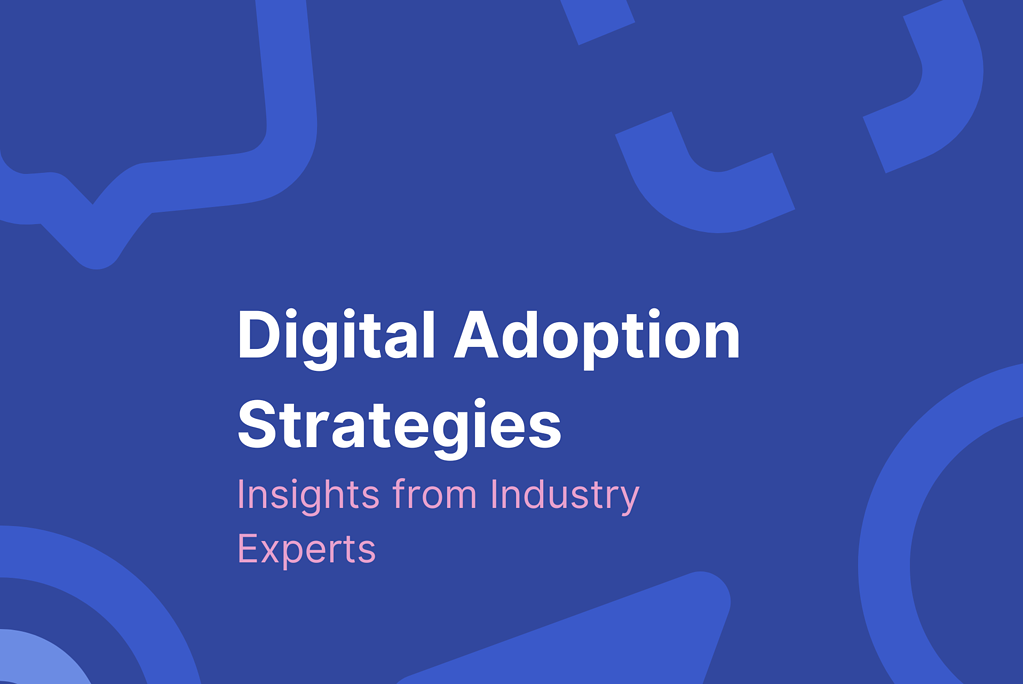The imperative of digital adoption for enterprises
Digital adoption is a strategic imperative for businesses aiming to thrive in the 21st century. With over 300,000 professionals on LinkedIn now holding titles related to digital adoption, the movement towards embracing digital technologies is undeniable. Enterprises are recognizing the need to adapt, not just to improve their internal processes but also to meet the evolving expectations of their customers.
Why digital adoption is non-negotiable
- Competitive edge. Digital tools and technologies offer businesses the tools to innovate, streamline operations, and deliver enhanced customer experiences. Enterprises lagging in digital adoption risk falling behind competitors who leverage technology to optimize their services and products.
- Operational efficiency. Digital tools and platforms enable automation of routine tasks, data analytics for informed decision-making, and streamlined workflows. This not only reduces operational costs but also helps to improve and increase user productivity and overall quality of service.
- Customer expectations. Modern consumers expect personalized, seamless interactions across digital channels. Enterprises must adopt digital technologies to meet these expectations, offering omnichannel experiences that align with customer preferences and behaviors.
Current key areas of focus for digital adoption
- Cloud computing. Migrating to cloud services offers flexibility, scalability, and cost-efficiency. It enables enterprises to adapt quickly to market changes and demand fluctuations without the need for significant upfront investment in IT infrastructure.
- Data analytics and AI. Leveraging data analytics and artificial intelligence allows enterprises to gain insights into customer behavior, operational efficiencies, and market trends. These insights can drive strategic decisions, personalize customer experiences, and identify new business opportunities.
- Cybersecurity. As digital adoption increases, so does the risk of cyber threats. Implementing robust cybersecurity measures is essential to protect sensitive data and maintain customer trust.
- Digital skills. Cultivating a workforce skilled in new digital technologies is crucial. Training and development programs ensure employees can effectively utilize digital tools and contribute to the digital transformation journey. A digital adoption platform can help alleviate user adoption and ensure each role within your organization receives proper training.

4 steps to a successful and comprehensive digital adoption strategy
Crafting a successful digital adoption strategy requires thoughtful planning and execution:
1. Assess and plan
Evaluate your current digital maturity and identify areas where digital assets can have the most significant impact. Develop a comprehensive digital adoption strategy that aligns with your business goals and objectives.
Start by utilizing tools or consultancies to evaluate your current digital capabilities versus industry benchmarks. For example, a retail company might assess their eCommerce platform’s functionality against leading competitors to identify gaps in customer experience.
Then, determine which parts of your business could benefit most from digital technologies. A logistics company, for instance, might identify route optimization and real-time tracking as areas where digital solutions could significantly enhance efficiency.
Create a detailed plan that includes timelines, investment needs, responsible teams, and expected outcomes. Ensure this roadmap is aligned with both short-term and long-term business objectives.
2. Engage stakeholders
Digital adoption is a company-wide endeavor. Engage stakeholders from all levels of the organization to ensure buy-in and support. Clear communication about the benefits and impact of digital adoption can foster a culture of change.
Identify all internal and external stakeholders who will be impacted by digital adoption, including employees, customers, and suppliers. For example, an IT firm implementing new project management software would involve project managers, developers, and client services teams in the process.
Based on this, develop a communication strategy that outlines how you will inform and involve stakeholders throughout the digital adoption process. This might include regular updates, Q&A sessions, and feedback mechanisms.
Next, identify and empower enthusiastic individuals within the organization who can advocate for the digital adoption process. These champions can help motivate their peers and facilitate smoother transitions.
3. Implement incrementally
Rather than a wholesale transformation, adopt a phased approach for your digital transformation efforts. Implement new technology and digital processes incrementally, allowing for adjustments based on feedback and results. This reduces risk and allows for more manageable change management.
Start with pilot projects to test new tools and technologies on a small scale before a full rollout. A healthcare, for instance, provider could pilot a new patient portal in one department before expanding it hospital-wide.
Remember to establish mechanisms for collecting and analyzing feedback from early adopters. This feedback can guide adjustments and improvements, ensuring that the technology meets users’ needs.
Based on the success of pilot programs and initial feedback, gradually expand the implementation across the organization. Plan this rollout in phases, each with its own set of goals, timelines, and metrics for success.
4. Measure and adjust
Establish metrics to measure the success of your digital adoption strategy. Regularly review these metrics and be prepared to adjust your strategy in response to performance data, technological advancements, or changing market conditions.
Before implementation, define clear metrics that will measure the impact of digital adoption. For a B2B software company, this might include customer acquisition costs, customer satisfaction scores, and employee productivity rates.
Schedule periodic review meetings to assess progress against these metrics. In these sessions, a manufacturing company could review how the adoption of IoT devices has affected production efficiency and product quality.
Use these insights gained from performance data to make continuous improvements. This could involve refining user training, upgrading software features, or even changing strategic directions based on evolving business needs or technological advancements.
Takeaways
- Conduct a digital audit. Start with a thorough audit of your current technology stack, processes, and digital skills within your organization. This will highlight areas of opportunity and gaps in your digital adoption strategy.
- Set clear digital adoption goals. Define what success looks like for your digital adoption strategy. Whether it’s improving customer satisfaction, increasing operational efficiency, or boosting sales, having clear goals will guide your strategy and investments.
- Invest in relevant training. Develop a comprehensive training program to upskill your workforce. Consider partnerships with technology providers for specialized training on new systems and software.

How to drive digital adoption in your organization
The human aspect of digital adoption – managing change to foster a culture of innovation and learning – is crucial for ensuring that your digital adoption strategy the related technology investments not only take hold but propel your organization forward.
Implementing the following digital adoption strategies effectively can steer your organization towards a successful digital future, avoiding common pitfalls that often hinder progress and result in poor digital adoption.
1. Strategic vision and planning
Leadership plays a pivotal role in setting the digital vision for the enterprise. A comprehensive digital adoption strategy begins with a clear understanding of how digital technologies align with the broader business goals. It’s about envisioning the future state of the business and mapping out the digital journey to get there.
Example
Consider a retail enterprise aiming to enhance its online presence to offer a seamless omnichannel experience to its customers. The leadership team sets a digital vision that includes not only launching an eCommerce platform but also integrating it with their physical stores for a unified customer experience.
They plan to achieve this by adopting a digital-first strategy, prioritizing digital initiatives, and setting clear milestones for implementation, such as deploying an e-commerce platform within six months, integrating it with existing POS systems in the next quarter, and using customer data analytics to personalize the shopping experience by the end of the year.
Do this:
- Conduct vision workshops. Involve key stakeholders in workshops to define the digital vision and align it with business objectives.
- Develop a digital roadmap. Create a detailed roadmap with specific projects, timelines, and responsible teams to achieve the digital vision.
- Set clear KPIs. Define key performance indicators (KPIs) to measure progress towards the digital vision and adjust strategies as needed.
2. Understanding Modernization Engineering
Rathi Rao, a senior manager at Sonata Software, emphasizes the importance of modernization engineering in digital adoption. This approach focuses on upgrading legacy systems with modern technologies and practices, ensuring that businesses can stay agile and innovative. Modernization engineering is crucial for businesses looking to migrate from on-premise technologies to cloud-based solutions.
Example
A manufacturing company using legacy systems for its supply chain management decides to modernize its IT infrastructure to improve efficiency and reduce costs.
By adopting modernization engineering practices, they migrate their supply chain management system to a cloud-based platform, enabling real-time inventory tracking, predictive maintenance of machinery, and automated supplier management.
Do this:
- Audit existing systems. Conduct a thorough audit of current IT systems to identify those requiring modernization.
- Prioritize based on impact. Prioritize modernization projects based on their potential impact on business operations and customer experience.
- Partner with technology experts. Collaborate with technology partners or consultants who specialize in modernization engineering to ensure a successful transition.
3. Leveraging Cloud SaaS Technologies
The shift towards Cloud Software as a Service (SaaS) technologies, such as Dynamics 365, marks a significant trend in digital adoption. These platforms offer businesses the flexibility to innovate and scale according to their needs, providing a foundation for a modern, digital-first infrastructure.
Example
A financial services firm looking to improve its customer service adopts a Cloud SaaS CRM platform like Salesforce. This enables them to centralize customer information, automate service requests, and use AI-driven insights to personalize customer interactions, significantly enhancing customer satisfaction and retention.
Do this:
- Evaluate cloud SaaS options. Assess various Cloud SaaS solutions to determine which best meets your business needs and objectives.
- Implement in phases. Roll out the Cloud SaaS solution in phases, starting with core functionalities before adding more complex features.
- Train your team. Ensure your team is trained on the new system to maximize its benefits and smooth the transition.
4. The Role of Change Management
Successful digital transformation requires more than just technical implementation; it demands a cultural shift within the organization. Change management strategies are essential for preparing, supporting, and helping individuals to successfully adopt these changes, ensuring the organization as a whole can move forward cohesively.
Best digital adoption strategies understand the importance of the user adoption process and plan for contextual and personalized training, often with the help of a digital adoption solution, like ClickLearn.
Example
An international logistics company introduces a new fleet management system to optimize delivery routes and reduce fuel consumption. Recognizing the significant changes this will bring to their operations, they implement a comprehensive change management program that includes employee training, regular communication updates, and feedback sessions to address concerns and ensure buy-in from all levels of the organization.
Do this:
- Develop a change management plan. Outline the steps needed to manage the organizational change, including communication strategies, training programs, and support structures.
- Communicate clearly and often. Keep all stakeholders informed about the reasons for the change, the benefits it will bring, and progress updates.
- Support and empower employees. Provide the necessary training and resources for employees to adapt to new tools and processes. Establish feedback mechanisms to listen to employee concerns and suggestions.

4 common mistakes with digital adoption strategies and how to avoid them
A robust digital adoption strategy is critical for businesses aiming to stay relevant and competitive. Understanding these common mistakes that are often made with digital transformation initiatives can help enterprises navigate the process more effectively.
1. Narrow vision without a comprehensive strategy
Companies sometimes focus too narrowly on individual technologies or short-term solutions without considering how these fit into the broader business strategy. This can lead to fragmented systems that don’t communicate well, wasted resources on technologies that don’t address core business needs, and missed opportunities for more impactful digital transformation.
How to avoid:
- Develop a holistic digital strategy. Ensure that any digital initiative aligns with the long-term goals and vision of the company. This strategy should encompass not just technology adoption but also how digital transformation will affect your business model, operational processes, and customer experience.
- Involve cross-functional teams in planning. Digital adoption impacts all areas of the business. Involving representatives from different departments in the planning process ensures that the strategy is comprehensive and considers the needs and challenges of the entire organization.
2. Underestimating the importance of company-wide buy-in
Implementing new digital tools and digital assets without securing buy-in from all levels of the organization can lead to resistance, lack of engagement, and even sabotage of digital initiatives. Leadership might be committed to the digital vision, but if the rest of the organization doesn’t understand or see the value in these changes, adoption efforts can stall.
How to avoid:
- Communicate the vision and benefits. Regularly communicate the digital vision and how it benefits the organization, including specific advantages for different teams and roles. This communication should be clear, consistent, and engaging, utilizing various formats to reach everyone in the organization.
- Foster a culture of inclusion and participation. Encourage input and feedback from employees at all levels during the planning and implementation phases of your digital adoption strategy. This not only helps in identifying potential issues early on but also makes employees feel valued and part of the digital transformation journey.
3. Inadequate training and support for new technologies
Even the best technologies can fail to deliver their intended benefits if the end-users are not properly trained or supported in their adoption. Lack of adequate training can result in underutilization, inefficiencies, and frustration among employees, undermining the investment in new technologies.
How to avoid:
- Comprehensive training programs. Develop and implement training programs that are tailored to different user groups’ needs. These programs should not only cover how to use the new technologies but also why they are important and how they fit into the broader business processes.
- Ongoing support and resources. Provide continuous support and resources beyond the initial training period. This can include help desks, online resources, refresher courses, and forums for sharing tips and best practices among users.
4. Failing to align digital adoption strategies with strategic objectives
Digital adoption efforts that are not aligned with the company’s strategic objectives can lead to misdirected efforts and resources. This misalignment can divert focus from critical business goals and reduce the overall impact of digital adoption.
How to avoid:
- Strategic alignment sessions. Hold regular sessions to review and ensure that digital initiatives are aligned with the strategic objectives of the company. These sessions should involve senior leadership and key stakeholders from across the business.
- Flexibility and adaptability. New technology is constantly evolving, and so are business needs. Ensure that your digital adoption strategy is flexible enough to adapt to these changes while staying aligned with your core business objectives.

Succeed in digital transformation with a Digital Adoption Platform
Developing a successful digital adoption strategy involves several key steps, starting with envisioning workshops and stakeholder engagement. Defining clear business outcomes and KPIs is crucial for measuring success, while a regular review of the technology portfolio helps to ensure that digital tools and platforms continue to meet the evolving needs of the business.
The concept of evergreen IT emphasizes the importance of keeping technology tools and platforms up-to-date, ensuring that businesses can respond swiftly to market changes and opportunities. Continuous modernization is not just about adopting the latest technologies; it’s about creating a culture that embraces change, innovation, and learning as part of the everyday business process.
Ensure the success of your digital adoption strategies through leveraging a comprehensive digital adoption platform (DAP) like ClickLearn. ClickLearn automates the creation of training materials and documentation, providing personalized, context-sensitive assistance directly within your digital tools.
This not only accelerates user adoption but also enhances proficiency and productivity across new software implementations. With ClickLearn, you can effectively bridge the gap between technology investments and achieving tangible business outcomes, ensuring your workforce is fully equipped to navigate and make the most out of new technology investment.
Digital Adoption Strategies FAQ
Digital adoption platforms (DAPs) are advanced software tools designed to facilitate and accelerate the adoption of new technologies within organizations. They play a crucial role in digital transformation efforts by offering in-app guidance, personalized training, and robust analytics to track user progress. DAPs help streamline processes, reduce the learning curve for new users, and optimize software utilization across the enterprise.
Digital adoption tools are essential because they directly address common challenges associated with introducing new technology, including user resistance, low engagement, and the inefficiency of traditional training methods. These tools provide real-time, contextual support to users, helping them navigate new features and processes confidently and efficiently, thereby enhancing overall user engagement and productivity.
Key digital adoption strategies include developing a clear adoption strategy that aligns with your overall business goals, using digital adoption solutions to provide in-app guidance and track user progress, and focusing on personalized training to meet the specific needs of your existing employees. It’s also critical to measure digital adoption rates and adjust your strategies based on user feedback and analytics to continuously improve user engagement.
An effective adoption strategy drives widespread digital adoption by clearly defining the objectives and benefits of new digital tools, ensuring alignment with business goals, and communicating these to all stakeholders. By leveraging digital adoption platforms and tools, businesses can offer tailored training and support, making it easier for users to understand and embrace new technology, thereby increasing adoption rates across the organization.
The benefits of digital adoption include improved operational efficiency, better customer experiences, enhanced employee productivity, and a competitive edge in the market. Successful digital adoption allows businesses to fully leverage their digital technology investments, streamline existing processes, and adapt more quickly to market changes and customer needs.
Personalized training is crucial because it addresses the unique learning needs and preferences of each user, helping to overcome resistance and accelerate competency with new technologies. By offering training in multiple formats and allowing users to learn at their own pace, organizations can improve engagement, reduce support tickets, and facilitate smoother user onboarding and adoption.
To ensure continuous digital adoption and user engagement, businesses should adopt a strategy that views digital adoption as an ongoing process. This involves regularly updating training materials to reflect new features and processes, using robust analytics to track user progress and identify areas for improvement, and engaging with users through in-app messages and other communication channels to offer support and collect feedback.
